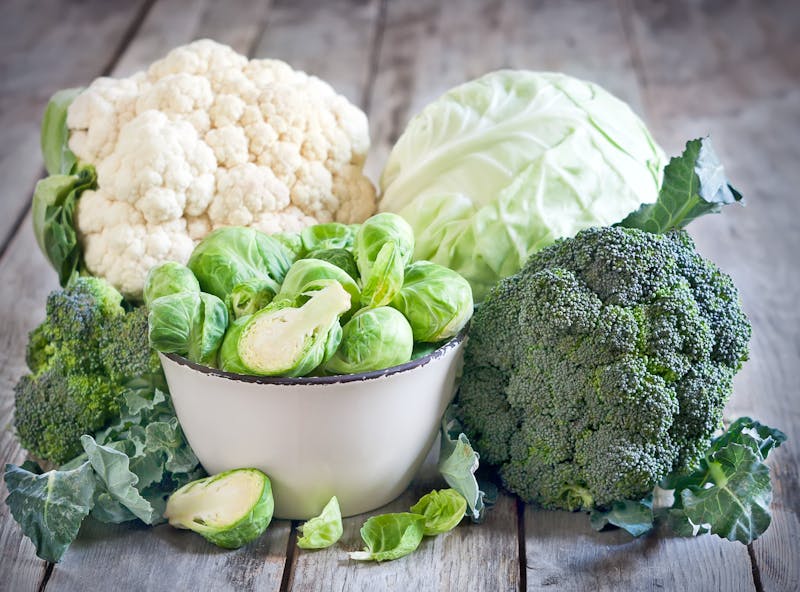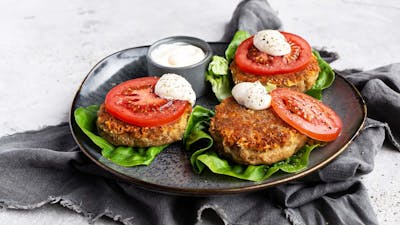Carbohydrates on a keto or low carb diet
- What are carbs?
- How are carbs processed in the body?
- Video: Carbohydrates on a low carb diet
- How are carbs used by the body?
- What are the benefits of restricting carbs?
- Do I need a minimum amount of carbs?
- The best carbs to eat on a keto or low carb diet
- What are “net carbs”?
- How many carbs should I eat per day?

What are carbs?
“Carb” is short for “carbohydrate.” Like the other macronutrients (major nutrients), protein and fat, carbs provide your body with energy (calories).
Watch a summary of this guide in video
There are two basic types of carbs in food: starches and sugars.
Starches
Starches are made up of long chains of individual glucose (sugar) units that are linked together.
The diagram below is a simplified depiction of the structure of starch.

Starchy foods generally don’t taste sweet.1 However, because starch is just a long chain of sugar (glucose) molecules linked together, once it’s digested in the gut, it’s absorbed into the blood as pure glucose, which raises blood sugar levels.2
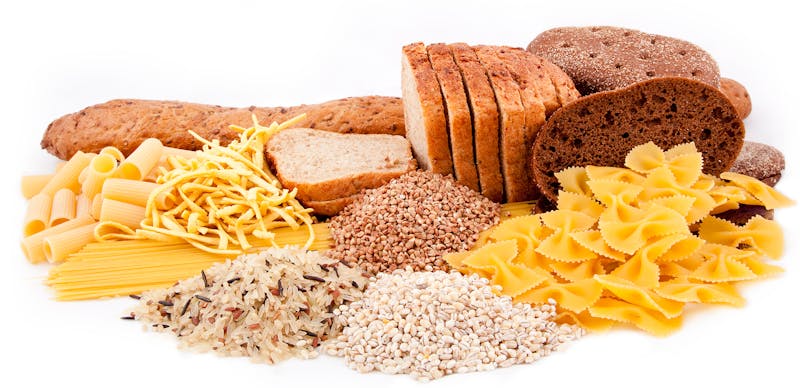



Examples of foods high in starch
- Rice
- Pasta
- Potatoes
- Cereal
- Bread
Sugars
Sugars are much shorter chains compared to starches. In fact, sometimes they are just a single glucose or fructose molecule. However, in food they’re usually two sugar molecules linked together, such as sucrose (glucose and fructose) or lactose (glucose and galactose).
Below are simplified depictions of a sucrose and a lactose molecule.
Sucrose
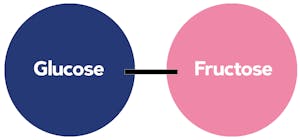

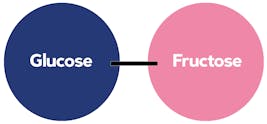


Lactose





Sugars are found in whole foods such as many plants and dairy products, but aside from fruit and root vegetables like carrots and beets, these foods don’t taste very sweet. Most vegetables, nuts and seeds only have tiny amounts of sugar.
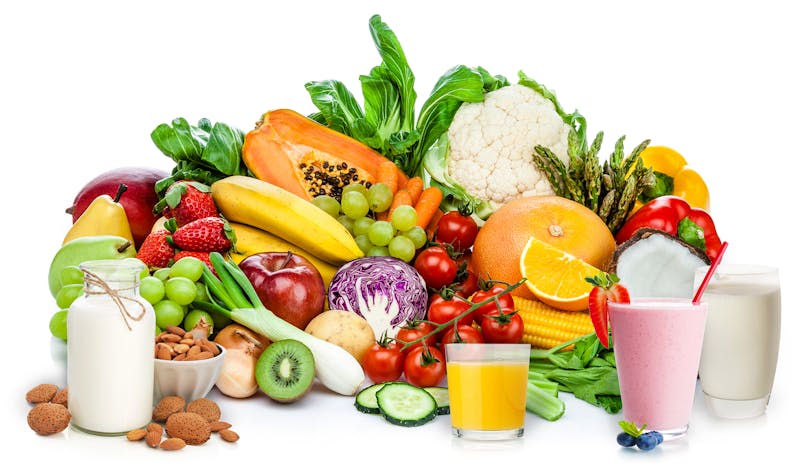



Examples of whole foods that contain sugar
- Fruit
- Vegetables
- Nuts and seeds
- Milk, yogurt and kefir
Processed and packaged foods often contain added sugars. Food manufacturers typically add refined sugar or high-fructose corn syrup to their products, although they sometimes use honey or other “natural” sugars that are considered healthier. But sugar is sugar, and your body processes all of it the same way.3




Examples of added sugars
- Refined white sugar and all other sugars: brown sugar, raw sugar, beet sugar, coconut sugar, turbinado sugar, etc.
- Dextrose
- High-fructose corn syrup
- Honey
- Maple syrup
- Molasses
- Agave nectar
More
To learn more about sugars and other sweeteners on a keto or low carb diet, check out our keto sweeteners guide.
How are carbs processed in the body?
Starches and two-unit sugars like sucrose and lactose are too big for your body to absorb. Therefore, after you eat carbs, your body produces enzymes that break them down into single sugar units that can be absorbed.
These single sugar units are handled by the body in different ways. To understand the effect of carbs on the body, it’s useful to know how glucose and fructose are absorbed.
Once glucose enters your bloodstream, it causes your blood sugar to rise immediately.4 This prompts your pancreas to produce insulin, the hormone that allows glucose to move out of your blood and into your cells. How much your blood sugar goes up – and how long it stays elevated – depends on a number of factors, including how many carbs you eat, how much insulin you produce, and how sensitive your cells are to insulin.
On the other hand, fructose doesn’t raise blood sugar the way glucose does.5 Instead, it goes straight to the liver, where it is converted to glycogen for storage.
Your liver can handle small amounts of fructose found in whole foods without difficulty.6 However, consuming processed foods and beverages high in fructose can overwhelm your liver’s ability to process it properly. High fructose intake on a regular basis may potentially lead to insulin resistance, fatty liver, and obesity.7
Agave nectar and other high-fructose “healthy” alternative sweeteners are often marketed as being “low glyemic index” because they don’t raise blood sugar as much as white sugar does. But they may possibly be an even worse choice than white sugar when it comes to your weight and health due to fructose’s adverse effects.8
Importantly, all digestible carbs, or net carbs, are absorbed and (with the exception of fructose) can raise blood sugar — whether they come from whole or refined grains, fruits, vegetables, or sugar itself.9
How does the body use carbs?
Once the carbs you’ve eaten are digested and absorbed, the glucose they provide can be used as an energy source by all the cells in your body, including those in your muscles, heart, and brain.
Glucose that isn’t immediately needed by these cells can be stored in your liver and muscles as glycogen (long chains of glucose, similar to starch in food). However, there’s a limit to the amount that can be stored. Once your glycogen storage sites are full, any additional glucose from the breakdown of excess carbs will be converted to fat and stored in your body, including your liver.10
What are the benefits of restricting carbs?
A keto or low carb diet provides several benefits, especially for people who want to get their blood sugar under control or lose weight:
- Lower levels of blood sugar and insulin.11
- Elimination of carb cravings.12
- Powerful appetite control.13
- Ability to go for many hours without eating due to feeling full and satisfied.14
More about the benefits of a low carb diet
Do I need to eat a minimum amount of carbs?
The short answer is no. In fact, you technically don’t need to eat any carbs at all.
When carbs are restricted, your body switches to using fat and ketones rather than sugar as its main energy source.15 Aside from your red blood cells and a small portion of your brain and kidneys, which do require glucose, your cells can use fatty acids or ketones as fuel.16 You can learn more about this in our complete guide to ketosis.
Your body is actually capable of making glucose for any cells that need it, even if you don’t consume any carbs. This is because your liver can convert amino acids (found in protein) and glycerol (found in fatty acids) into glucose. This process is known as gluconeogenesis.
In their 2005 textbook “Dietary Reference Intakes for Energy, Carbohydrate, Fiber, Fat, Fatty Acids, Cholesterol, Protein, and Amino Acids,” the U.S. Food and Nutrition Board of the Institute of Medicine states:
“The lower limit of dietary carbohydrate compatible with life apparently is zero, provided that adequate amounts of protein and fat are consumed.”17
Interestingly, there are nine essential amino acids found in protein and two essential fatty acids, but there is no such thing as an “essential” carbohydrate.
However, there are valuable nutrients in many low carb foods that contain some carbs, such as vegetables, nuts, and seeds. These foods also provide fiber, flavor and texture, which can enhance your eating experience.
Best of all, including them in your diet will still allow you to experience the benefits of a low carb or keto lifestyle.
The best carbs to eat on a keto or low carb diet
By choosing your carbs wisely you should still be able to keep your blood sugar within healthy limits, while nourishing your body with important vitamins and minerals. Adding some carbs to your diet may also make your low carb lifestyle more sustainable, fun, colorful and varied.
Here are some of the best sources of carbs on a keto or low carb diet:
- Broccoli
- Cauliflower
- Kale
- Leafy greens
- Asparagus
- Avocado
- Macadamia nuts
- Pumpkin seeds
- Raspberries
What are “net carbs”?
“Net carbs” refer to the amount of carbs a food contains after subtracting the fiber.
It’s generally accepted that the fiber in whole foods isn’t digested and absorbed.18 However, not all experts on carb-restricted diets agree on this point.
Additionally, in people with type 1 diabetes, fiber may distend the stomach and trigger the release of hormones that raise blood sugar.19 Therefore, you can either subtract the fiber carbs in whole food to get the ‘net carbs’ or count total carbs, depending on your personal preference and tolerance.
Here is an example of how to calculate net carbs: 100 grams (3.5 ounces) of cauliflower contains 5 grams of total carbs, 2 of which come from fiber.
5 grams of total carbs minus 2 grams of fiber = 3 grams of net carbs.
On the other hand, many processed low carb foods display labels indicating their “net carbs,” which reflect their total carbs minus added fiber and sweeteners known as sugar alcohols. Studies have shown that some of these additives can be partially absorbed and raise blood sugar levels.20 Therefore, the term “net carbs” on packaged foods may be very misleading.
When calculating net carbs, only subtract fiber from whole foods. In any case, we recommend sticking with whole foods and avoiding processed and packaged “low carb” products.
How many carbs should I eat per day?
Not everyone needs the same carb restriction for optimal health. Healthy, physically active, and normal-weight individuals may not necessarily have to restrict carbs at all, especially if they choose minimally-processed sources most of the time.21
However, for people with a range of health issues or weight problems, it’s often beneficial to keep carb consumption relatively low. Generally speaking, the lower the carbs, the more effective for weight loss and for metabolic health problems like type 2 diabetes.22
At Diet Doctor, we define three different levels of carb restriction as follows:
- Ketogenic: less than 20 grams of net carbs per day
- Moderate low carb: 20-50 grams of net carbs per day
- Liberal low carb: 50-100 grams of net carbs per day
To learn more about these levels and how to choose the one that’s best for you, be sure to check out our helpful guide, How low carb is low carb?
Start your FREE 30-day trial!
Get instant access to healthy low carb and keto meal plans, fast and easy recipes, weight loss advice from medical experts, and so much more. A healthier life starts now with your free trial!
Start FREE trial!
Top posts by Franziska Spritzler
Carbohydrates on a keto or low carb diet - the evidence
This guide is written by Franziska Spritzler, RD and was last updated on January 11, 2023. It was medically reviewed by Dr. Bret Scher, MD on June 24, 2020.
The guide contains scientific references. You can find these in the notes throughout the text, and click the links to read the peer-reviewed scientific papers. When appropriate we include a grading of the strength of the evidence, with a link to our policy on this. Our evidence-based guides are updated at least once per year to reflect and reference the latest science on the topic.
All our evidence-based health guides are written or reviewed by medical doctors who are experts on the topic. To stay unbiased we show no ads, sell no physical products, and take no money from the industry. We're fully funded by the people, via an optional membership. Most information at Diet Doctor is free forever.
Read more about our policies and work with evidence-based guides, nutritional controversies, our editorial team, and our medical review board.
Should you find any inaccuracy in this guide, please email andreas@dietdoctor.com.
However, when starches are made industrially or packaged in food products, they are often combined with sugar which will make them tase sweet ↩
Studies have shown that starchy foods like rice and bread can raise blood sugar as much as sweet foods:
Journal of Insulin Resistance 2016: It is the glycemic response to, not the carbohydrate content of food that matters in diabetes and obesity: the glycemic index revisited [case series; weak evidence] ↩
In one study, when people with impaired glucose tolerance were assigned to eat honey, white sugar, or high-fructose corn syrup for two weeks each, they experienced similar increases in blood sugar, triglycerides, and inflammatory markers regardless of which sugar they’d consumed:
Journal of Nutrition 2015: Consumption of honey, sucrose, and high-fructose corn syrup produces similar metabolic effects in glucose-tolerant and -intolerant individuals [randomized crossover trial; moderate evidence] ↩
BMC Medicine 2011: A systematic review on the effect of sweeteners on glycemic response and clinically relevant outcomes [systematic review of randomized trials; strong evidence] ↩
BMC Medicine 2011: A systematic review on the effect of sweeteners on glycemic response and clinically relevant outcomes [systematic review of randomized trials; strong evidence] ↩
American Journal of Clinical Nutrition 2008: Fructose consumption and consequences for glycation, plasma triacylglycerol, and body weight: Meta-analyses and meta-regression models of intervention studies [systematic review of randomized trials; strong evidence] ↩
In studies, overweight and obese adults who consumed high-fructose beverages for 10 weeks gained weight and experienced a worsening of insulin resistance and heart disease risk factors:
The Journal of Clinical Investigation 2009: Consuming fructose-sweetened, not glucose-sweetened, beverages increases visceral adiposity and lipids and decreases insulin sensitivity in overweight/obese humans [randomized controlled trial; moderate evidence]
European Journal of Clinical Nutrition 2012: Consumption of fructose-sweetened beverages for 10 weeks reduces net fat oxidation and energy expenditure in overweight/obese men and women [randomized controlled trial; moderate evidence]
Some, although not all, reviews on dietary fructose conclude that consuming it on a regular basis may lead to metabolic health issues:
Nutrition and Metabolism 2005: Fructose, insulin resistance, and metabolic dyslipidemia [overview article; ungraded evidence]
Nutrients 2017: Fructose consumption, lipogenesis, and non-alcoholic fatty liver disease [overview article; ungraded evidence] ↩
The Journal of Experimental Biology 2018: Fructose-containing caloric sweeteners as a cause of obesity and metabolic disorders [overview article; ungraded] ↩
Diabetes Care 2004: Dietary carbohydrate (amount and type) in the prevention and management of diabetes [overview article; ungraded] ↩
International Journal of Obesity 2004: Effect of carbohydrate overfeeding on whole body macronutrient metabolism and expression of lipogenic enzymes in adipose tissue of lean and overweight humans [non-controlled study; weak evidence]
The American Journal of Clinical Nutrition 1988: Glycogen storage capacity and de novo lipogenesis during massive carbohydrate overfeeding in man [non-controlled study; weak evidence]
The American Journal of Clinical Nutrition 2012: Effect of short-term carbohydrate overfeeding and long-term weight loss on liver fat in overweight humans [non-controlled study; weak evidence] ↩
These studies demonstrate that a low carb diet reduces both blood sugar and insulin levels:
The European Journal of Clinical Nutrition 2017: The interpretation and effect of a low carbohydrate diet in the management of type 2 diabetes: a systematic review and meta-analysis of randomised controlled trials [strong evidence]
American Journal of Clinical Nutrition 2010: Lack of suppression of circulating free fatty acids and hypercholesterolemia during weight loss on a high-fat, low carbohydrate diet [randomized controlled trial; moderate evidence]
Annals of Internal Medicine 2005: Effect of a low carbohydrate diet on appetite, blood glucose levels, and insulin resistance in obese patients with type 2 diabetes [non-randomized study; weak evidence] ↩
Nutrition X 2019: Effects of differing levels of carbohydrate restriction on mood achievement of nutritional ketosis, and symptoms of carbohydrate withdrawal in healthy adults: A randomized clinical trial [randomized controlled trial; moderate evidence]
Nutrients 2019: Changes in food cravings and eating behavior after a dietary carbohydrate restriction intervention trial [non-controlled study; weak evidence] ↩
Obesity Reviews 2015: Do ketogenic diets really suppress appetite? A systematic review and meta-analysis [strong evidence] ↩
Nutrition, Metabolism & Cardiovascular Diseases 2016: The effects of a low carbohydrate diet on appetite: A randomized controlled trial [randomized controlled trial; moderate evidence] ↩The physiology of ketone production and utilization has been well described in the medical literature. Below are 3 review articles that expand into more detail about the process
Diabetes and Metabolism Reviews 1989: Ketone body production and disposal: effects of fasting, diabetes, and exercise. [overview article; ungraded]
Annual Reviews in Biochemistry 1980: Regulation of hepatic fatty acid oxidation and ketone body production. [overview article; ungraded]
Annual Reviews in Nutrition 2006: Fuel metabolism in starvation. [overview article; ungraded] ↩
The American Journal of Clinical Nutrition 2007: Low carbohydrate nutrition and metabolism[overview article; ungraded] ↩
Institute of Medicine of the National Academies 2005:Dietary reference intakes for energy, carbohydrate, fiber, fat, fatty acids, cholesterol, protein, and amino acids [textbook chapter; ungraded] ↩
Nutrients 2010: Effects of dietary fiber and its components on metabolic health [overview article; ungraded] ↩
This is based on the clinical experience of Dr. Richard K. Bernstein and other clinicians who treat patients with type 1 diabetes.[weak evidence] ↩
A portion of the processed fiber known as isomaltooligosaccharide (IMO) can be absorbed in the intestine like non-fiber carbs, which may raise blood sugar:
European Journal of Clinical Nutrition 2003: Comparison of digestibility and breath hydrogen gas excretion of fructo-oligosaccharide, galactosyl-sucrose, and isomalto-oligosaccharide in healthy human subjects [non-controlled study; weak evidence]
Bioscience, Biotechnology and Biochemistry 1992: Metabolism of (13)C-isomaltooligosaccharides in healthy men [non-controlled study; weak evidence]
Maltitol, the most common sugar alcohol in packaged low carb treats, has the highest glycemic index and insulin index of all sugar alcohols, and approximately 50% is absorbed in the digestive tract:
Nutrition Research Reviews 2003: Health potential of polyols as sugar replacers, with emphasis on low glycaemic properties [overview article; ungraded evidence]
European Journal of Clinical Nutrition 1994: Digestion and absorption of sorbitol, maltitol and isomalt from the small bowel: a study in ileostomy subjects [randomized controlled trial; moderate evidence]
Gastroentérologie Clinique et Biologique 1991: Clinical tolerance, intestinal absorption, and energy value of four sugar alcohols taken on an empty stomach [randomized controlled trial; moderate evidence] ↩
This is based on consistent clinical experience of low carb practitioners. [weak evidence] ↩
In several studies, diets providing less than 50 grams of carbs per day have produced excellent weight loss and blood sugar results:
Obesity Reviews 2016: Impact of low carbohydrate diet on body composition: meta-analysis of randomized controlled studies [strong evidence]
Journal of medical Internet research 2017:An online intervention comparing a very low carbohydrate ketogenic diet and lifestyle recommendations versus a plate method diet in overweight individuals with type 2 diabetes: A randomized controlled trial [randomized trial; moderate evidence]
Nutrition & Metabolism 2008: The effect of a low carbohydrate, ketogenic diet versus a low-glycemic index diet on glycemic control in type 2 diabetes mellitus [randomized trial; moderate evidence] ↩

